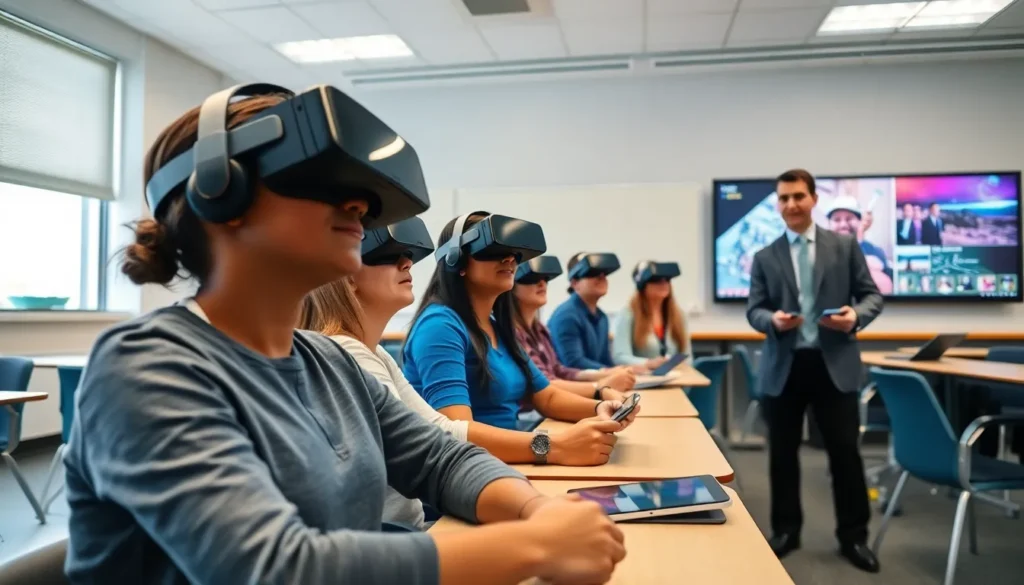Table of Contents
ToggleImagine walking down the street and suddenly spotting a dragon perched on a lamppost. No, it’s not a scene from a fantasy movie; it’s augmented reality (AR) bringing a sprinkle of magic to the mundane. AR is revolutionizing how people interact with the world, merging digital elements with real-life experiences in ways that are both entertaining and informative.
Overview Of Augmented Reality
Augmented reality (AR) enhances the real world by overlaying digital information onto physical environments. This technology integrates computer-generated images, sounds, and other sensory inputs, creating interactive experiences. Users engage with AR through devices like smartphones, tablets, and smart glasses, enabling seamless interactions with both physical and digital elements.
Applications of AR span various industries. In retail, businesses use AR to help customers visualize products before purchase. For instance, furniture companies offer AR tools that allow shoppers to see how a couch looks in their living room. Education also benefits from AR by providing immersive learning experiences. Students can explore complex subjects, such as anatomy, through 3D models that bring lessons to life.
Moreover, gaming represents a prominent example of AR technology. Games like Pokémon GO illustrate how AR blends virtual characters with real-world settings, encouraging players to explore their surroundings. Marketing professionals leverage AR for campaigns that engage consumers and create memorable brand interactions. Companies utilize AR to craft unique advertising experiences, allowing users to interact directly with their brand.
Statistics reflect AR’s growing influence. According to a report by Statista, the AR market is projected to reach approximately $198 billion by 2025. This growth indicates a rising adoption of AR across various sectors. Understanding AR’s capabilities and implications provides insights into its future potential. As technology advances, it’s likely that AR will continue to reshape interactions with the world, paving the way for more innovative applications.
Applications Of Augmented Reality
Augmented reality transforms multiple sectors by enhancing experiences with digital overlays. Various industries reap benefits from AR technology’s innovative applications.
In Education
AR enriches the educational landscape, creating interactive learning environments. Students engage with 3D models, allowing an in-depth understanding of complex concepts. Visualizing historical events, scientific phenomena, or anatomical structures fosters retention and curiosity. Technologies like AR apps and virtual field trips encourage exploration beyond traditional textbooks. Teachers utilize AR to create immersive lessons, making learning enjoyable and impactful.
In Healthcare
Healthcare professionals benefit from AR in numerous ways. Surgeons employ AR systems to visualize patient anatomy during procedures, enhancing precision and safety. Medical students gain hands-on experience through simulations, bridging theory and practice. Training programs integrate AR, helping practitioners master skills in a controlled environment. Patient education also improves, as AR visualizes treatment plans, making complex information accessible. The potential for improved outcomes due to AR’s accuracy continues to expand.
In Retail
Retailers leverage AR to enhance shopping experiences for customers. Virtual try-on features allow consumers to see how clothing, accessories, or makeup products look before purchasing. This technology reduces return rates, increasing customer satisfaction and confidence. Interactive displays engage shoppers, providing essential product information. Augmented reality also supports personalized marketing campaigns, capturing consumer attention in competitive markets. As the retail landscape evolves, AR plays a crucial role in shaping customer interactions.
Benefits Of Augmented Reality
Augmented reality (AR) provides numerous advantages across various fields. Businesses increasingly leverage its power to enhance experiences and drive engagement.
Enhanced User Experience
AR significantly improves user experiences by offering interactive elements that blend seamlessly with the real world. Users can visualize products, learn concepts through 3D models, or navigate environments with added information layers. For example, in retail, customers try on clothes virtually, allowing them to make informed choices. In education, students engage with lessons more deeply, facilitating understanding of complex topics through immersive content. By transforming how individuals interact with their surroundings, AR fosters more informative and enjoyable experiences.
Increased Engagement
Engagement levels soar when AR becomes part of marketing strategies. Brands utilize AR to create captivating campaigns that draw customers in and encourage exploration. For instance, interactive advertisements or games not only entertain but also inform users, crafting memorable connections with the brand. In gaming, titles like Pokémon GO showcase how AR engages players, pushing them to explore their communities actively. This heightened engagement translates to increased brand loyalty and customer retention, proving AR’s role as a vital tool in modern marketing efforts.
Challenges Of Augmented Reality
Challenges exist that impact the widespread adoption of augmented reality (AR). These issues may hinder its potential in various applications.
Technical Limitations
Technical limitations present significant barriers to AR development. Current hardware struggles with processing power, affecting real-time rendering of complex graphics. Battery life also poses challenges, as prolonged use drains device energy quickly, which limits user experience. Connectivity issues can interrupt AR functionalities, especially in areas with weak internet signals. Developers often face difficulties in creating seamless integration of digital elements into physical environments. As AR technology evolves, addressing these technical constraints remains crucial to expanding its applications.
Privacy Concerns
Privacy concerns arise with the growing use of AR technology. Users often question how personal data, accessed through AR applications, is stored and utilized. Regulation around data protection creates uncertainty for developers and users alike. Unauthorized data collection can lead to security breaches, compromising sensitive information. Moreover, the potential for tracking user movements raises ethical dilemmas. Ensuring transparent practices in data handling will be essential for fostering trust between users and AR providers. Tackling these privacy issues is vital for the long-term success of AR in societal applications.
Future Trends In Augmented Reality
Growing interest in augmented reality (AR) technology indicates its increasing integration into daily life. Innovations in AR applications are emerging across several sectors, including education and healthcare. Educational institutions are adopting AR tools that enable interactive learning environments. Students engage with 3D models, enhancing their comprehension of complex subjects.
Healthcare professionals utilize AR for precision training and real-time surgical assistance. Surgeons rely on AR overlays to visualize anatomy during operations, potentially increasing success rates. The training of medical students benefits from simulation programs that replicate real-world scenarios.
Retail spaces are optimizing AR features that enhance customer experiences. Virtual try-on systems allow shoppers to visualize products accurately before purchase. Retailers notice higher conversion rates and decreased return rates due to improved shopper satisfaction.
Marketing departments are embracing AR to create captivating brand experiences. Companies design interactive campaigns through AR, enabling consumers to connect with brands on a deeper level. Such innovative strategies boost engagement and brand loyalty, influencing purchasing decisions.
Advancements in hardware technology drive future AR developments. More powerful processors and better battery life facilitate real-time rendering, improving user satisfaction. As companies invest in AR infrastructure, significant improvements in connectivity are expected.
Privacy concerns remain critical in the discussion about AR’s future. Safeguarding personal data ensures user trust and societal acceptance. Surveillance and data tracking issues call for transparent policies and ethical standards.
Overall, AR is well-positioned for expansive growth. Industry projections estimate the AR market to reach around $198 billion by 2025, signaling robust potential across various domains.
Augmented reality is reshaping how individuals interact with their surroundings and access information. Its applications across diverse fields like education retail and healthcare demonstrate its versatility and potential to enhance experiences. As AR technology continues to evolve it promises to offer even more innovative solutions that engage users and improve outcomes.
However challenges such as technical limitations and privacy concerns must be addressed to ensure widespread acceptance and success. As the market grows and advancements in hardware emerge AR is set to become an integral part of daily life. With its projected market growth the future of augmented reality holds exciting possibilities that could redefine interactions across various sectors.




